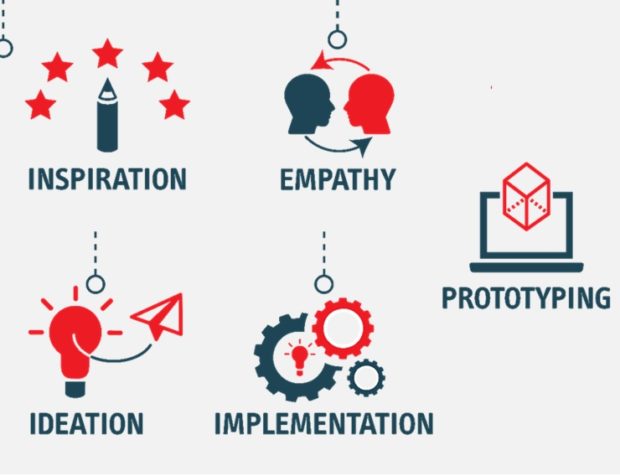Design thinking is a methodology used by designers to solve complex business problems and find desirable practical solutions always with the focus on the benefit to the end user.
Design thinking is very much a collaborative approach that draws upon logic, imagination, intuition and systemic reasoning to explore possibilities of what could be. It combines a series of traditional design techniques, such as personas, empathy maps, as-is scenarios, design ideation, to-be scenarios, hypothesis-driven design and minimum viable product (MVP) definition.• A persona is an archetype of a user that helps designers and developers empathize by understanding their users’ business and personal contexts.
• Empathy maps are “quick and dirty” works-in-progress that capture and articulate facets of a representative user as currently understood and viewed by a design team. The facets are thinks, feels, says and does—shown in four distinct quadrants of a map, with the user or persona sketched in the middle.
On a large design team, not everyone has the chance to talk to every user. Empathy maps help synthesize the team’s collective knowledge about users as a group, bringing you closer to a common understanding of who they are.
• As-is scenarios gather the design team’s understanding to give a clear picture of your users’ current activity. In other words, an as-is scenario map documents the team’s collective understanding of user workflows, helping them find the right problem to solve.
This activity involves asking what is our user “doing, thinking, feeling” throughout his or her experience with your product or service.
• Design ideation is the process of generating big ideas. Team members are asked to brainstorm a number of big ideas to solve the user problems discovered from as-is scenarios. A key to the exercise is to refrain from using that same kind of thinking that created the problems in the first place.
• To-be scenarios for personas are developed by asking what the persona’s ideal journey might be. They can help you envision a better future for your users. Like “as-is” scenario maps, the activity involves asking what is your user “doing, thinking, feeling” throughout his or her experience with your reimagined product or service. The to-be scenario map is something that can be put in front of stakeholders and users to align on your team’s intent.
• Hypothesis-driven design is design based on hypotheses (provisional conjectures about customer responses to design) instead of requirements (specifications of something that must be built and delivered to customers). When a critical hypothesis is disproven, you might need to pivot and create another set of hypotheses.
Using hypotheses recognizes that the world is complex and changing. Rather than wasting time and resources, hypothesis-driven design means experimenting early and often, soliciting customer feedback, and discarding any new features that provide little benefit or hinder customers.
• Minimum viable product is the smallest possible version of a product that can be used to run a meaningful experiment to test key hypotheses and determine whether to continue investment.
Experiences have shown that design thinking results in practical, imaginative, purpose-focused solutions that can be delivered iteratively—always with the end-user’s satisfaction in mind. The process always involves the end user or representatives of the target audience.
Sources: Craig Bedell and IBM at https://www.ibm.com/design/thinking/page/toolkit/ and https://www.ibm.com/garage/method/practices/think/





















 California Workers Comp Combined Ratio for 2024 Highest in 20-Plus Years
California Workers Comp Combined Ratio for 2024 Highest in 20-Plus Years  NOAA Announces Latest AI-Driven Global Weather Models
NOAA Announces Latest AI-Driven Global Weather Models  Good Times for U.S. P/C Insurers May Not Last; Auto Challenges Ahead
Good Times for U.S. P/C Insurers May Not Last; Auto Challenges Ahead 




